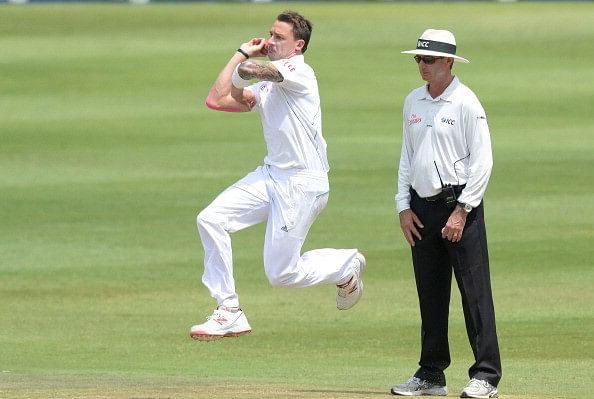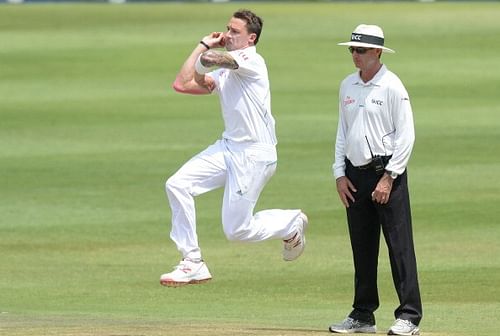
Dale Steyn and James Anderson - The greatest contemporary fast bowlers

What is greatness if it can’t be proven by stats? True, stats can’t turn mediocrity into greatness but anyone who wants to stake a claim on a slot in the Hall of Fame, needs to rack up the numbers, especially in cricket, where every day, some player in some corner of the world is registering a significant milestone.
Dale Steyn took his 400th wicket against Bangladesh on Day 1 of the Second Test joining a very select group of fast bowlers, who went that far. He has stoked an interesting rivalry as well, with another contemporary fast bowling great, James Anderson, who recently became the first English fast bowler to reach the milestone and join the 400 wickets’ club.
Well both the bowlers have bragging rights in some departments of the whole art of fast bowling. Steyn is still, the better of the two, on many counts. In a generation that began close on the heels of greats like Wasim Akram, Glenn McGrath, Brett Lee and Waqar Younis, Steyn and Anderson are the two brightest stars. One wonders how much longer will they be at their peak with Anderson, turning 33 but, cricket is surely exciting for their presence.
In many ways it is easy to throw up tables and tables explaining the feats of these two fast bowlers but that doesn’t really do justice to their talent. Once again, what is greatness, if one table can sum it all? So, we take a look at various aspects of their wicket-taking ability and how it has ebbed and flowed over the years for the two champion bowlers.
Overall record
|
|
Total Wickets |
Home |
Away |
Average |
Strike-Rate |
|
James Anderson |
413 |
266 |
147 |
29.38 |
57.6 |
|
Dale Steyn |
402 |
227 |
175 |
22.48 |
41.5 |
There is a reason why Steyn is so dangerous. He averages almost seven runs fewer than Anderson, miserly and extremely efficient. He is not a fast bowler who leaks runs. Anderson isn’t either, which is why his average is below 30. Amongst contemporary fast bowlers, there are not many who have managed a better average than Anderson, barring Mitchell Johnson, whose 300 Test wickets have been taken at an average of under 28.
But, the Englishman lags both the aforementioned fast bowlers in a very important department – serious pace. He is a very skillful bowler. He can move the ball either ways at will, where Steyn is predominantly an outswing bowler.
Anderson can reverse it beautifully and has a deadly wobbly-seam delivery that bounces and moves unpredictably. With their own specific set of strengths, these two fast bowling greats have tormented batsmen across the globe.
Record in the sub-continent
|
|
Wickets in Asia |
Average |
Strike-Rate |
|
James Anderson |
42 |
32.21 |
67.7 |
|
Dale Steyn |
90 |
22.33 |
39.7 |
This is a very revealing stat. Steyn has 90 wickets in 19 games played in Asia (India, Bangladesh, UAE, Pakistan and Sri Lanka) whereas Anderson has 42 in 14 Tests. More than the wickets, it is the average and strike rate that is amazing.
The South African has a better average and strike-rate on the placid sub-continental pitches than his overall career stats. That says a lot about his penetrative bowling and how feared he is around the world. There is a reason why he is a superstar in the IPL too and has a large number of fans.
He can make things happen in unfriendly conditions. For someone bred on excellent pace-bowling friendly surfaces to develop the skill and temperament to be just as successful on flatter, less conducive wickets is a great feat in itself.
Across time-frames
|
|
Wickets Last 12 months |
Average |
Wickets Last 2 years |
Average |
Wickets Last 5 years |
Average |
|
James Anderson |
42 |
23.09 |
93 |
28.38 |
237 |
27.04 |
|
Dale Steyn |
27 |
17.77 |
70 |
21.67 |
191 |
21.77 |
This is another interesting table that shows how both the bowlers are at the peak of their prowess right now. Dale Steyn has 27 wickets in just six Tests played in the last 12 months compared to Anderson’s 10 Tests.
Yet, both the fast bowlers have averaged almost six runs fewer than their career averages. Interestingly, over a period of 24 months, too, their averages are better than their career averages and the same holds true for a five year period.
In other words, in the last 10 years, which is more of less the time frame of the rivalry, both fast bowlers have gotten better and better, reducing the averages in each time frame. Both are fine athletes, although Steyn has an extra year, since he is only 32 years old.
Interestingly, over the last two years, neither Steyn nor Anderson have been the most lethal of fast bowlers. Mitchell Johnson in the last 24 months has 96 wickets at an average of 20.9 and a strike rate of 40.6, better on both counts than Steyn. Yet, the South African is only behind Johnson over the last 24 months in terms of incision but his consistency has been the real key.
Over the last one year, Josh Hazlewood has 37 to Anderson’s 42 but at a better average and a way better strike-rate. Once again, that goes to show, that the gap between James Anderson and Dale Steyn and the rest of the fast bowling pack is narrowing, in spite of both fast bowlers being in their prime. A good example is Anderson’s partner Stuart Broad, who has 44 wickets to Anderson’s 42 but at a way better strike-rate and a comparable average.
Incisiveness of the 400 club
|
Player |
Wickets |
Average |
Strike-rate |
|
Glenn McGrath |
563 |
21.64 |
51.9 |
|
Courtney Walsh |
519 |
24.44 |
57.8 |
|
N Kapil Dev |
434 |
29.64 |
63.9 |
|
Sir Richard Hadlee |
431 |
22.29 |
50.8 |
|
Shaun Pollock |
421 |
23.11 |
57.8 |
|
Wasim Akram |
414 |
23.62 |
54.6 |
|
James Anderson |
413 |
29.38 |
57.6 |
|
Curtly Ambrose |
405 |
20.99 |
54.5 |
|
Dale Steyn |
402 |
22.48 |
41.5 |
This is another interesting table that throws light across the numbers of the nine fast bowlers who have taken more than 400 Test wickets. Interestingly, Steyn’s is not the lowest average, not the second lowest either. He is fourth behind, McGrath, Hadlee and Ambrose. But, his strike-rate is stellar. It is nine balls fewer than the next lowest which is 50.8 for Hadlee. In other words, Steyn takes a wicket every seven overs.
Even in the list of bowlers with 300 wickets or more, Steyn has the best strike-rate, with Waqar Younis boasting of a strike-rate of 43.4. Johnson is the closest to Steyn amongst all contemporary bowlers with a strike-rate of 50.6.
However, across the last 24 months, Steyn has the third lowest strike-rate with Johnson and Josh Hazlewood boasting of a better average and strike-rate. Stuart Broad with 50.0 has the next lowest strike-rate with other potential next-gen bowlers like Trent Boult, Mitchell Starc and Mohammad Shami falling way behind in the range of 54 to 58.
Conclusion
The aim of this piece wasn’t to find out a winner amongst contemporary bowlers. It was to dissect the whole art of contemporary fast bowling, to see where the relevance of Steyn and Anderson lies. In terms of wickets, Anderson is amazingly relevant, but not so much in terms of strike-rate.
He doesn’t strike the same fear as Steyn. In fact, there are many contemporary fast bowlers who are doing way better in that department. Yet, very few have gone on doing what Anderson does consistently enough to reach 400 Test wickets.
Steyn will definitely end up way ahead of Anderson, given his fitness and time-frame. Allan Donald’s prediction that Steyn will finish with more than 500, is just basic common sense. With four good years, Steyn might even end up as the most prolific fast bowler of all time, given he needs about 160 wickets to go there.
In his best year, he managed more than a whopping 70 wickets and there is no reason why he cannot repeat that. It will be hard to better Steyn’s strike rate, which might stand the test of time, for fast bowling isn’t getting any easy with bigger bats and flatter wickets changing the dynamics of the game!